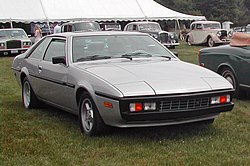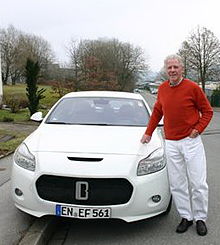
Bitter

 |
|
|
Type
|
GmbH |
|---|---|
| Industry | Automotive |
| Founded | Schwelm, Germany (1971) |
| Founder | Erich Bitter |
| Headquarters | Schwelm, Germany |
|
Area served
|
Europe |
| Products | Automobiles |
| Website | Bitter |
Erich Bitter Automobil GmbH (Bitter) is a premium sports-luxury automobile marque produced in Germany and later Austria.
Founder Erich Bitter, a former racing driver turned automobile tuner, importer and ultimately designer began crafting his own vehicles after business ventures with Italian manufacture Intermeccanica ended
Bitter specialises in rebodying other manufacturer's vehicles and its initial production was between 1973 and 1989, selling vehicles in Europe and the United States. Thereafter, several prototypes followed with an eye on resuming low-volume production, but none of those plans came to fruition until the launch of the Bitter Vero in 2007.
CD


The Bitter CD, a three-door hatchback coupe featuring a 227 hp (169 kW) Chevrolet V8 with a 327ci displacement, was built between 1973-1979.
The CD was first shown in prototype form on 9 September 1969 at the Frankfurt Auto Show, as the Opel Coupé Diplomat ("CD") derived from the sedan version. It was designed by Charles M. "Chuck" Jordan (Opel's Design boss between 1967-1971 and later vice-president of General Motors (GM)) with the assistance of George A. Gallion, David Holls, Herbert Killmer and Hideo Kodama, as well as Erhard Fast (Director of the Opel Designstudios 3 for Advanced Design from 1964). The tail was inspired on a proposal by Erhard Fast's for the 1969 Opel Aero GT.
Thanks to the positive reaction to the CD prototype, Opel considered developing a production models. The doors would adopt a conventional opening system and the bumper bar, windshield wipers and other parts would be derived from the Opel Diplomat in order to facilitate production and maintain costs. Robert "Bob" Lutz, who was the Head of Opel at the time and was keen to produce the car, commissioned Pietro Frua to advance the concept and produce two road-going prototypes.
In 1971, it was David R. "Dave" Holls (Opel design boss since 7/1971; previously assistant to Chuck Jordan) who encouraged Erich Bitter to build the Bitter CD. As a result, Bitter GMBH was formed in 1971 to market the CD. He based his company on a 1-acre (4,000 m2) site in his home town of Schwelm, Germany.
However, because he did not have the necessary capital and other resources to set up his own production facilities, Bitter turned to Baur GMBH in Stuttgart, as a proven independent small-scale manufacturer. He selected them given their ability to produce high-quality prototypes and limited production cars for other German manufacturers.
Bitter based his original CD designs on those of Frua, before making alterations closer to production. The basic design changes to Frua's CD design vis-à-vis the 1969 Opel CD consisted of a truncated read end, modified windshield and less chrome application. Dave Holls and Opel's design team supplemented the design with a small front spoiler, larger grille, higher bumper bars and by prolonging upwards the lower edge of the rear side windows across the C pillar to the rear hatch. Final prototype testing was conducted at the Opel Test Facility in Duden, in addition to load duration tests by Bitter at the Hydropulseur facility of Baur.
The Baur team also engaged in significant constructive and production development work, which included manufacturing a hard foam mockup. Their role then extended to manufacturing the CD's body panels, assembling the shell, interior fitting and trimming as well as installing the Opel Diplomat's mechanicals.
The Bitter CD was displayed, with great success, at the 1973 Frankfurt Motor Show, where Erich Bitter took 176 orders for his stylish new coupe. However, the oil crisis at the time led to the cancellation of most orders. Despite this, production commenced late the same year at Baur GMBH. The target of 200 units/year was never realised and, in total, Bitter sold 395 units. Purchase price in 1974 was 58,400 DM.
- Total production by year
| 1973 | 1974 | 1975 | 1976 | 1977 | 1978 | 1979 | Body in white |
|---|---|---|---|---|---|---|---|
| 6 | 99 | 79 | 73 | 71 | 30 | 37 | 5 |
SC




The first SC model launched was the coupé in 1979, followed by the convertible in 1981 at the Frankfurt Auto Show and the sedan in 1984. Like the CD, the SC was based on Opel's largest model at the time, the Opel Senator. It remained in production until 1989.
Exterior styling design echoed that of the Pininfarina-designed Ferrari 365 GT4 2+2 first shown in 1972, and later marketed as the 400 (1976) and 412 (1979). The SC was powered by a fuel-injected Opel 3.0-Litre in-line 6-cylinder engine of (177 hp (132 kW)) or a stroked 3.9-Litre version of (207 hp (154 kW)).
Along with the introduction of the convertible in 1981, a four-wheel drive version of the coupé was also added. The four-wheel drive system was developed by Ferguson Research who also offered it for installation into the Opel Senator/Vauxhall Royale.
In 1984, Bitter announced at the New York Auto Show that it would enter into a limited marketing agreement with GM to sell the sedan version in the United States, through participating Buick dealerships. By being able to offer a premium European product, GM had hoped to (re)gain market share lost to BMW at the time. The option of importing Opel cars was dismissed on the basis that it was perceived to be an entry-level brand, relative to BMW's premium status. Ultimately, less than a dozen Buick dealers (mostly in the metro New York City area), would bear the Bitter signage as a result of which sales proved minimal. Bitter's failure was based on its business model, and the diminishing trend of rebodying other manufacturers' vehicles, which became unpopular by the 1980s.
- Total production by bodyshape
| Coupé | Convertible | Sedan |
|---|---|---|
| 461 | 22 | 5 |
CD II
In 2003, in an attempt to resume its small-scale production, Bitter presented a modern reincarnation of the CD, known as the CD II. It was based on the Australian-made Holden Monaro but rumoured to feature a V12 engine. Investors were sought but the car never reached full production.
Vero

In 2007, Bitter resumed small-scale production by launching the Vero at the 2008 Geneva Motor Show. This car was derived from the Australian-made Holden Caprice (WM) sedan (the long-wheelbase luxury derivative of the Holden Commodore (VE)), believed to be purchased directly from Holden thanks to Erich Bitter's friendship with Holden's former Peter Hanenberger.
Relative to the donor car, the Vero features unique restyling claimed to have cost A$1 million, which take about a week to apply. In particular, the vehicle is shod 20 inch alloy wheels and has a prolonged bonnet along with a redesigned front bumper incorporating a new grille, and an additional rear bumper insert to house rear foglights required in Europe. Its leather-trimmed interior featured luxury fittings from the donor car such as a DVD player and screens in the back of the front headrests for rear passengers. The donor car's Chevrolet V8 6.0-Litre 362 CV (266 kW) engine, with a six-speed automatic transmission, remained unchanged.
The Vero was sold in Germany for €121,975 and was discontinued in 2012.
Vero Sport
In 2009, Bitter unveiled a "Vero Sport" at the Geneva Motor Show. Unlike the regular Holden Caprice (WM)-derived Vero, the Sport was directly based on the short-wheelbase Holden Commodore (VE) SS sedan, also sold as the Chevrolet SS in the United States. Like the Vero, the Vero Sport was also discontinued in 2012.
Future models

Bitter is intending to base its next production model on the Opel Insignia OPC.





